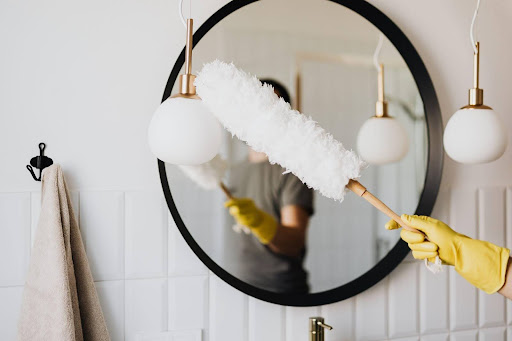
 Loading... Please wait...
Loading... Please wait...Save Money. Grow Your Own!
Fast Plain Box Shipping.
We ship to the US & Canada.
Posted on 16th Feb 2024

Creating a healthier home environment is more than just a lifestyle choice; it's a commitment to enhancing the well-being of yourself and your loved ones. In today's world, where we spend much of our time indoors, the significance of having a safe living space cannot be overstated. From improving air quality to reducing exposure to harmful chemicals, small changes in your home can make a big difference in your health.
Let’s look at some tips and things you can do to create a healthier home environment.
The air inside our homes can be more polluted than outside, thanks to dust, pet dander, mold spores, and volatile organic compounds (VOCs) from paints and furnishings.
To combat these invisible threats, start by ventilating your home regularly. Opening windows daily, even for a few minutes, can drastically improve air quality by allowing fresh air in and pollutants out. Consider investing in air purifiers, especially for bedrooms and other frequently used areas, to filter out particulates and allergens.
Asbestos, once a common construction material due to its fire-resistant properties, can still be found in many homes built before the 1980s. When asbestos fibers become airborne—often during renovations or wear and tear—they pose a significant health risk if inhaled.
Asbestos exposure can lead to serious diseases, such as mesothelioma, a rare but aggressive form of cancer. Many people living with mesothelioma were initially misdiagnosed, given the disease's ability to mimic symptoms of more common conditions. To ensure your home is safe, consider hiring a professional to conduct an asbestos inspection, especially before undertaking any remodeling projects.
This precautionary measure can help avert the health hazards of asbestos exposure and the challenges of a potential mesothelioma misdiagnosis.
Household cleaning agents can sometimes do more harm than good, releasing harsh chemicals into your home's environment. Switching to natural cleaning solutions can significantly reduce your exposure to these substances. Simple ingredients like vinegar, baking soda, and lemon juice can effectively tackle everything from window cleaning to tile scrubbing.
Not only are these alternatives safer for your health, but they are also eco-friendly and cost-efficient. By making this switch, you'll reduce the chemical load in your home, leading to better indoor air quality and a safer living space for children and pets.
Adequate ventilation is key to preventing the buildup of moisture, odors, and airborne contaminants. This is particularly important in areas like kitchens and bathrooms, where moisture and odors are more prevalent. Make sure exhaust fans are functional and used during and after cooking or showering to draw pollutants and excess humidity out of your home. Cleaning these fans regularly ensures they operate efficiently.
Additionally, consider integrating cross-ventilation by opening opposite windows, which can quickly refresh the entire house without the need for artificial air fresheners or dehumidifiers.
Dust not only detracts from the cleanliness of your home but can also aggravate allergies and respiratory issues. To minimize dust, stick to a regular cleaning schedule, focusing on high-traffic areas and surfaces where dust accumulates. A vacuum cleaner equipped with a HEPA filter can capture more dust and allergens than traditional vacuums.
Similarly, opting for microfiber cloths over feather dusters can trap dust more effectively, preventing it from becoming airborne again.
When painting walls or choosing new furniture, volatile organic compounds (VOCs) in traditional products can significantly impact indoor air quality. VOCs are emitted as gases from certain solids or liquids, contributing to indoor air pollution and potential health risks. Opt for low-VOC or VOC-free paints, which are readily available and provide a safer alternative without compromising quality or durability.
Similarly, when selecting furniture, flooring, or cabinetry, look for materials certified as low-emission. By choosing non-toxic materials, you reduce your exposure to harmful chemicals, ensuring a safer environment for your family.
Maintaining the right humidity level inside your home is vital for comfort and health. High humidity can encourage the growth of mold and dust mites, while low humidity can lead to dry skin, irritation, and respiratory discomfort. Use a hygrometer to monitor your home's humidity levels, aiming to keep them between 30% and 50%. Utilize dehumidifiers in damp areas like basements and bathrooms to control moisture levels.
Additionally, fixing leaks promptly and ensuring good ventilation can help maintain optimal humidity, creating a more comfortable and healthier living environment.
Maximizing natural light in your home reduces the need for artificial lighting and offers numerous health benefits. Exposure to natural light boosts vitamin D levels, enhances mood, and improves sleep by helping regulate your circadian rhythms. Consider rearranging your space to allow for maximum sunlight exposure, using mirrors to reflect light into darker areas, and choosing window treatments that let light in while preserving privacy.
Embracing natural light creates a more vibrant and energizing living space, contributing to your overall well-being.
Indoor plants do more than just beautify your space; they play a role in improving air quality and enhancing your mood. Plants like snakes, spiders, and peace lilies can filter out common volatile organic compounds (VOCs) and increase oxygen levels. The presence of plants has also been shown to reduce stress and boost productivity.
By incorporating a variety of indoor plants into your home, you create a living environment that looks great and promotes a healthier lifestyle.
Creating a healthier home environment is an ongoing endeavor that requires conscious effort and dedication. From choosing non-toxic materials and maintaining optimal humidity to embracing natural light and ensuring kitchen hygiene, each step contributes to a safer, more nurturing living space. The goal is not just to create a beautiful home but one that actively supports your health and the well-being of your family.
By implementing these ten tips, you'll be well on your way to transforming your home into a haven of health and comfort, where every room contributes to a lifestyle that is not only healthier but also more joyful and fulfilling.